Tags
Being neither mad dogs or Englishmen, it was time to get out of the hot midday sun. Or at least time to quit walking in it. Sisavangvong Road, the main tourist drag in Luang Prabang isn’t all that long. It’s walkable from one end to the other, but only if you really feel the need. We didn’t. Plus we were working off a hand drawn map of the town furnished by our hotel. The marked locations of sites worthy of a visit were approximated at best. Meaning they were chalked in somewhere on the paper. We’d already learned a quarter of inch on the map could mean the distance of two buildings or a dozen blocks.
Our goal was the Golden Wat, Xieng Thong one of the towns more famous temples and one that all guide books and websites noted as a must-see. Fortunately it was famous enough that the tuk tuk driver we stopped to haggle with knew right where it was. And for a measly 10,000 kip (down from the 50,000 he’d started with) the ride was ours.
There are a lot of wats in Luang Prabang and we’d already checked out a few handfuls during the trip. Within a minute or two of heading off in our tuk tuk, my friend Noom pointed out a low slung temple complex brimming with novice monks, suggesting we stop there on the way back. Noted, location somewhat affixed in mind, we sailed down Sisavangvong Road to its end, followed a short road down toward the river and soon arrived at our destination: a nice set of stairs to climb to get up to Wat Xieng Thong.
Wat Xieng Thong is considered to be the most beautiful temple in Laos. Built where the Nam Khan flows into the Mekong River during the golden years of Lan Xang Kingdom, its gracefully sloping roof and glass murals epitomize the classical Luang Prabang style of temple architecture. Until 1975, when the Communist Party gained control over Laos, Wat Xieng Thong was a royal temple. It was the place where the former kings of Laos were crowned. Now it is the final resting place of one of Laos’ last royal families.
Gold is not an unusual color to find in Buddhist wats. The small temple by our hotel positively glowed so much gold had been used in its decoration. So I was expecting some major bling at the Golden Wat. And that’s the first thing you notice about Wat Xieng Thong. It’s not gold. After the buildup that would have been disappointing except instead of gold they went with aqua, an unusual color for a wat. The myriad shades of greens and blues glittering off glass mosaic statuary and the base of the ubosot mimic the colors of the Mekong flowing past its main entrance. It’s a striking color scheme and the expansive grounds are dotted with small temples and chapels, shrines and pavilions, and shady garden areas filled with colorful ornamental shrubs and trees blazing with blossoms.
The bot is painted a glossy black lacquer and decorated with figures and symbols in gold leaf. There’s plenty of gold evidenced by the gilded entrance too. The ubosot’s boundary stones (bai sema) however are covered in glass tiles; they are large lotus blossom figures in jewel tones of blue and green, much more distinct than bai sema usually are. The exterior was remolded and redecorated in the 1960s, but inside you are quickly transported back a hundred years.
Even with the doors and wood shutters open, the interior of the bot is dark. But the illumination offered by candles and small lanterns add an earthy glow to the Buddha statues and images, and is bright enough that you can make out the small figures in gold leaf that illustrate the daily activities of a Lao village on its walls and doors.
Across the courtyard, a carved and gilded building is the home to the cremation chariot and funeral urns of the Lao Royal Family. The building also serves as a depository for hundreds of carved wooden Buddha statues. Its interior walls are covered with mosaics that show scenes from the Ramayana. But it is the massive funeral urns and chariot that get the attention of visitors. My friend Noom, having discovered the day before that the Lao people had killed their King and Queen during the 1970s, clicked his tongue in disgust and went off to find a Buddha to talk the matter over with. Different set of dead royals in the funerary hall though.
The three large sandalwood urns contain the ashes of King Sisavang Vong, who ruled from 1904 to 1946, and his mother and father (the ashes of the Queen are at a nearby wat). It was built in 1962 to house the 40 foot high gilded wooden royal carriage that was used to carry the remains of King to his cremation near Wat That Luang. Incredibly ornate, the hearse is dominated by seven nagas with gaping jaws and prominent fangs at its prow and an elaborate red canopy supported by gilded and ornate columns at its center.
Wat Xieng Thong’s wiharn is often called the Red Chapel, the exterior is covered with pinkish colored stucco inlaid with brightly colored glass mosaics that illustrate both religious activities and everyday Lao traditional village life. Inside is a bronze reclining Buddha statue fashioned in the classic Lao style and clad in flowing robes. The interior is decorated with gold stencils on red walls with numerous small gold Buddhas attached to the walls.
Nearby and similar in look to the Red Chapel is the small but exquisite Tripitaka Library which historically houses the three baskets of Theravada Buddhist scriptures. The Seated Buddha Pavilion, a more modern construction than the other structures within the complex, is tucked into a shady spot by the Tripitaka Library and features a life-sized seated Buddha in the Calling the Earth to Witness position.
After close to two hours of touring the temple we decided to exit toward town rather than toward the river where we came in. A short walk, with no stairs involved, took us back out onto Sisavangvong Road. And half a block down the street was the wat Noom had pointed out when we were in the tuk tuk. I’m not sure if the driver took us the long way around so we’d feel like we’d gotten value for our $1.25 ride, or, being Laotian, knew the experience just wouldn’t be the same if we didn’t have a flight of stairs to climb to get there.
Wat Xieng Thong is opened daily from 6:00 am to 6:00 pm. Admission is 20,000 kip.

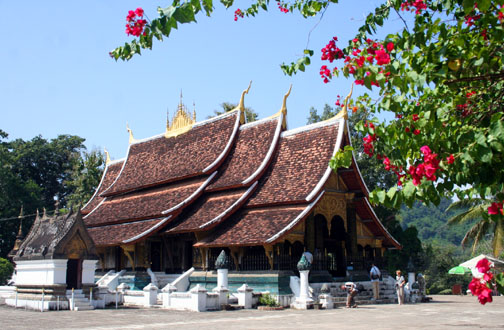
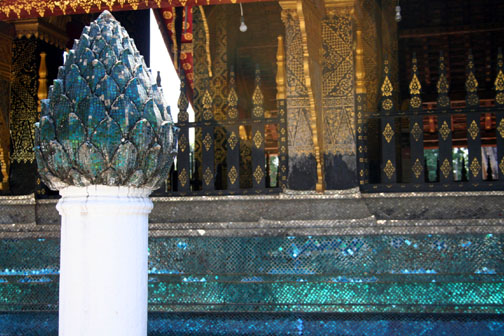
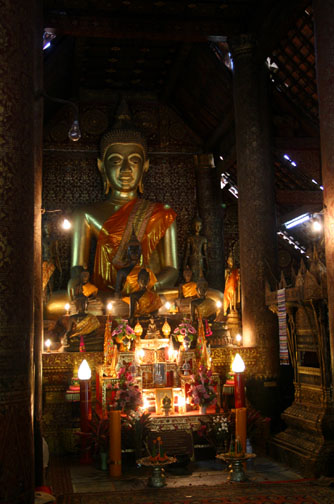

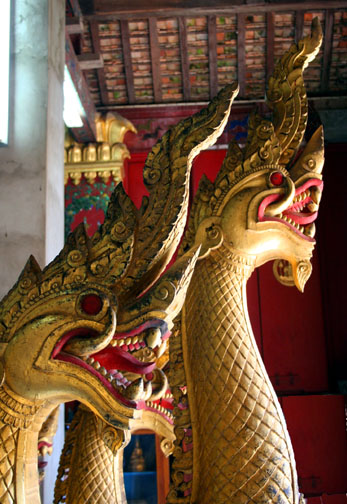
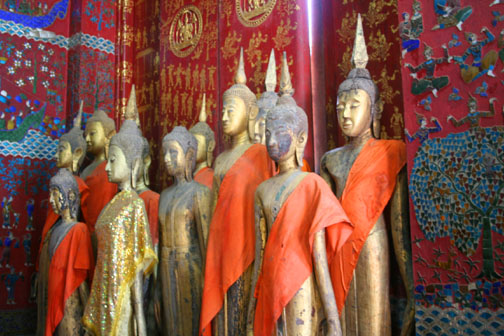
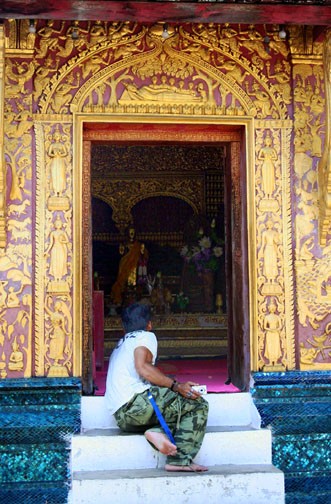
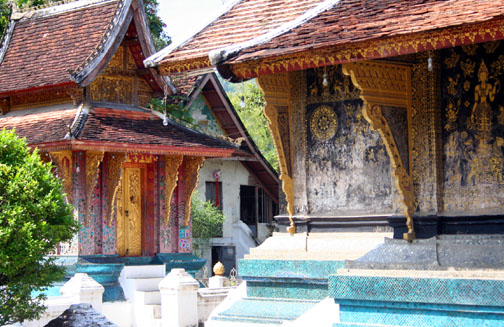
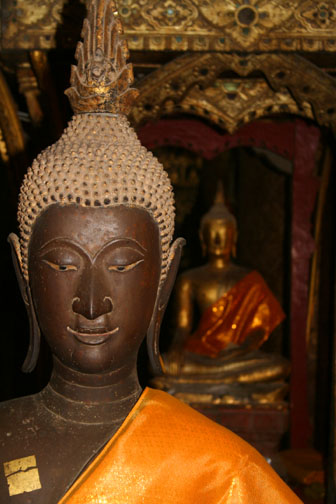
I am not much into the temples in Bangkok…too much ornamentation gives me a sensory overload that I fail to see the beauty in them. But with your photos, they do give me a fresh perspective especially when you zero in on the details. Occasionally seeing “Noom” on some of the photos is like seeing an old friend.
Well B, they do say the devil is in the details, no?
🙂
Noom was rather obvious in this shot, so I noted his appearance. But he shows up in a lot of interior temple shots I post, usually because he’s busy chatting with the Buddha while I’m snapping photos. And I always enjoy seeing him too, thanks.
I was most intrigued the little roof ornaments on the wats in Laos that I have never seen anywhere else.
Yup, Glenn, those are unique to Lao temples, little crowns (for lack of a better term) in the middle of the roof line, they are called Dok So Fa. I will be soon posting a piece about several odd architectural details you only see on Laos temples